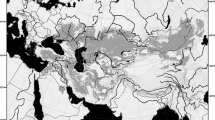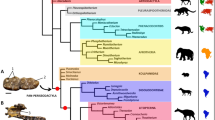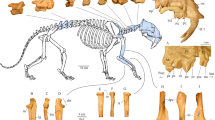Abstract
Extant eutherian mammals and their most recent common ancestor constitute the crown group Placentalia. This taxon, plus all extinct taxa that share a more recent common ancestor with placentals than they do with Metatheria (including marsupials), constitute Eutheria1. The oldest well documented eutherian-dominated fauna in the world is Dzharakuduk, Uzbekistan2. Among eutherians that it yields is Kulbeckia, an 85–90-Myr-old member of Zalambdalestidae (a family of Late Cretaceous Asian eutherians)3. This extends Zalambdalestidae back by some 10 million years from sites in the Gobi Desert, Mongolia4. A phylogenetic analysis of well described Late Cretaceous eutherians strongly supports Zalambdalestidae, less strongly supports ‘Zhelestidae’ (a Late Cretaceous clade related to Tertiary ungulates), but does not support Asioryctitheria (a group of Late Cretaceous Asian eutherians). A second analysis incorporating placentals from clades that include rodents (Tribosphenomys), lagomorphs (Mimotona) and archaic ungulates (Protungulatum and Oxyprimus) strongly supports Zalambdalestidae in a clade with Glires (rabbits, rodents and extinct relatives) and less strongly ‘Zhelestidae’ within a clade that includes archaic ungulates (‘condylarths’). This argues that some Late Cretaceous eutherians belong within the crown group Placentalia. The ages of these taxa are in line with molecularly based estimates of 64–104 Myr ago (median 84 Myr ago) for the superordinal diversification of some placentals5, but provide no support for a Late Cretaceous diversification of extant placental orders.
This is a preview of subscription content, access via your institution
Access options
Subscribe to this journal
Receive 51 print issues and online access
$199.00 per year
only $3.90 per issue
Buy this article
- Purchase on Springer Link
- Instant access to full article PDF
Prices may be subject to local taxes which are calculated during checkout



Similar content being viewed by others
References
Rougier, G. W., Wible, J. R. & Novacek, M. J. Implications of Deltatheridium specimens for early marsupial history. Nature 396, 459–463 (1998).
Archibald, J. D. et al. Précis of the paleontology, biostratigraphy, and sedimentology at Dzharakuduk (Turonian?–Santonian), Kyzyklum Desert, Uzbekistan. New Mex. Mus. Nat. Hist. Sci. Bull. 14, 21–28 (1998).
Nessov, L. A. Cretaceous Nonmarine Vertebrates of Northern Eurasia 168–169 (Univ. St. Petersburg Institute of Earths Crust, St Petersburg, 1997).
Kielan-Jaworowska, Z., Novacek, M. J., Trofimov, B. A. & Dashzeveg, D. in The Age of Dinosaurs in Russia and Mongolia (eds Benton, M. J. et al.) 573–626 (Cambridge Univ. Press, Cambridge, 2000).
Murphy, W. J. et al. Molecular phylogenetics and the origins of placental mammals. Nature 409, 614–618 (2001).
Kumar, S. & Hedges, B. A molecular timescale for vertebrate evolution. Nature 392, 917–920 (1998).
Foote, M., Hunter, J. P., Janis, C. M. & Sepkoski, J. J. Jr Evolutionary and preservational constraints on origins of biologic groups: divergence times of eutherian mammals. Science 283, 1310–1314 (1999).
Archibald, J. D. & Deutschman, D. H. Quantitative analysis of the timing of the origin and diversification of extant placental orders. J. Mamm. Evol. 8, 107–124 (2001).
Novacek, M. J., Gao, K., Norell, M. A. & Rougier, G. Ghost lineages, phylogeny, and ranges of selected vertebrate lineages across the K/T boundary. J. Vert. Paleontol. Abstr. 18 (suppl. 3), 67A (1998).
Archibald, J. D. Fossil evidence for a Late Cretaceous origin of “hoofed” mammals. Science 272, 1150–1153 (1996).
McKenna, M. C. & Bell, S. K. Classification of Mammals above the Species Level 104–105, 284 (Columbia Univ. Press, New York, 1997).
Cooper, A. & Fortey, R. Evolutionary explosions and the phylogenetic fuse. Trends Ecol. Evol. 13, 151–156 (1998).
Kielan-Jaworowska, Z. & Dashzeveg, D. Eutherian mammals from the Early Cretaceous of Mongolia. Zool. Scripta 18, 347–355 (1989).
Cifelli, R. L. Tribosphenic mammals from the North American Early Cretaceous. Nature 401, 363–366 (1999).
Averianov, A. O. & Skutschas, P. A new genus of eutherian mammal from the Early Cretaceous of Tranbaikalia, Russia. Acta Palaeontol. Pol. 46, 431–436 (2001).
Kielan-Jaworowska, K. Preliminary data on the Upper Cretaceous eutherian mammals from Bayn Dzak, Gobi Desert. Palaeontol. Pol. 19, 171–191 (1969).
Nessov, L. A. New Mesozoic mammals of middle Asia and Kazakhstan and comments about evolution of theriofaunas of Cretaceous coastal plains of Asia. Trudy Zool. Inst. 249, 105–133 (1993).
Martin, T. in Tooth Enamel Microstructure (eds von Koenigswald, W. & Sander, P. M.) 163–175 (Balkema, Rotterdam, 1997).
Luckett, W. P. in Evolutionary Relationships among Rodents: A Multidisciplinary Analysis (eds Luckett, W. P. & Hartenberger, J.-L.) 227–276 (Plenum, New York, 1985).
Lopatin, A. V. & Averianov, A. O. A new species of Tribosphenomys (Mammalia: Rodentiaformes) from the Paleocene of Mongolia. New Mex. Mus. Nat. Hist. Sci. Bull. (in the press).
Maddison, W. P. & Maddison, D. R. MacClade 3.07 (Sinauer, Sunderland, Massachusetts, 1997).
Swofford, D. L. PAUP: Phylogenetic Analysis Using Parsimony, Version 4.0b7 (Sinauer, Sunderland, Massachusetts, 2001).
Nessov, L. A., Archibald, J. D. & Kielan-Jaworowska, Z. Ungulate-like mammals from the Late Cretaceous of Uzbekistan and a phylogenetic analysis of Ungulatomorpha. Bull. Carnegie Mus. Nat. Hist. 34, 40–88 (1998).
Wible, J. R., Rougier, G. W., Novacek, M. J. & McKenna, M. C. Earliest eutherian ear region: A petrosal referred to Prokennalestes from the Early Cretaceous of Mongolia. Am. Mus. Novit. 3322, 1–44 (2001).
Li, C. K. & Ting, S. Y. in New Cranial and Postcranial Evidence for the Affinities of the Eurymylids (Rodentia) and Mimotonids (Lagomorpha) (eds Szalay, F. S., Novacek, M. J. & McKenna, M. C.) 151–158 (Springer, New York, 1993).
Archibald, J. D. in Tertiary Mammals of North America. Vol. 1. Terrestrial Carnivores, Ungulates, and Ungulatelike Mammals (eds C. Janis, C., Scott, K. & Jacobs, L.) 292–331 (Cambridge Univ. Press, Cambridge, 1998).
Novacek, M. J. et al. Epipubic bones in eutherian mammals from the Late Cretaceous of Mongolia. Nature 389, 483–486 (1997).
Vaughan, T. A., Ryan, J. M. & Czaplewski, N. J. Mammalogy 4th edn 73 (Saunders, Fort Worth, Texas, 2000).
Szalay, F. S. Evolutionary History of the Marsupials and an Analysis of Osteological Characters 35–58, 362 (Cambridge Univ. Press, Cambridge, 1994).
Marshall, L. G., Case, J. A. & Woodburne, M. O. Phylogenetic relationships of the families of marsupials. Curr. Mamm. 2, 433–505 (1990).
Archibald, J. D. & Averianov, A. O. Description of new material and revision of the Late Cretaceous mammal Kulbeckia (Eutheria, Zalambdalestidae). J. Vert Paleontol. (in review).
Acknowledgements
The continued cooperation of the Zoological Institute, National Academy of Sciences of Uzbekistan, and particularly D. A. Azimov and Y. Chikin, is much appreciated. We thank the URBAC expedition members A. Abramov, I. Danilov, C. King, N. Morris, A. Resvyi, C. Skrabec, P. Skutschas, H.-D. Sues and D. Ward for their field help and scientific expertise. We also thank S. Azadov, A. Khodjaev, A. Salikhbaev, V. Savin, O. I. Tsaruk, B. G. Veretennikov, N. I. Kuchersky, V. V. Novikov, V. V. Poverennov, A. Prokhorenko and N. I. Pronin. We thank M. Novacek, G. Rougier and J. Wible for sharing their ideas, unpublished results and specimens. A. Berta, R. Etheridge and T. Reeder commented on the manuscript and T. Reeder helped with the analyses. The financial support of the National Geographic Society, the National Science Foundation, the Navoi Mining and Metallurgy Combinat, and the San Diego State University International Programs is gratefully acknowledged.
Author information
Authors and Affiliations
Corresponding author
Supplementary information
Rights and permissions
About this article
Cite this article
Archibald, J., Averianov, A. & Ekdale, E. Late Cretaceous relatives of rabbits, rodents, and other extant eutherian mammals. Nature 414, 62–65 (2001). https://doi.org/10.1038/35102048
Received:
Accepted:
Issue Date:
DOI: https://doi.org/10.1038/35102048
This article is cited by
-
Jaw shape and mechanical advantage are indicative of diet in Mesozoic mammals
Communications Biology (2021)
-
A new Eocene anagalid (Mammalia: Euarchontoglires) from Mongolia and its implications for the group’s phylogeny and dispersal
Scientific Reports (2018)
-
Evolutionary transition of dental formula in Late Cretaceous eutherian mammals
The Science of Nature (2015)
-
Systematics and Phylogeny of Paleocene-Eocene Nyctitheriidae (Mammalia, Eulipotyphla?) with Description of a new Species from the Late Paleocene of the Clarks Fork Basin, Wyoming, USA
Journal of Mammalian Evolution (2015)
-
Divergence time estimates of mammals from molecular clocks and fossils: Relevance of new fossil finds from India
Journal of Biosciences (2009)
Comments
By submitting a comment you agree to abide by our Terms and Community Guidelines. If you find something abusive or that does not comply with our terms or guidelines please flag it as inappropriate.



